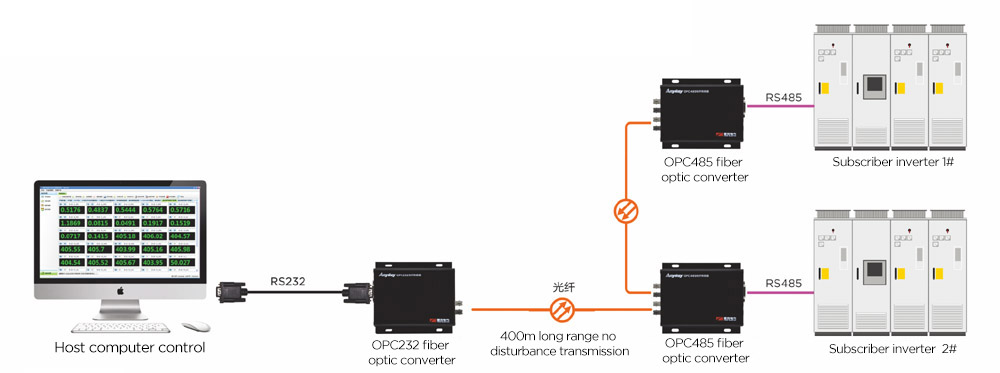OneSummary
RS485 bus standard is the industry (attendance, monitoring, data acquisition system, distributed measurement and control) widely used, two-way balanced transmission standard interface, support multipoint connection, it is a good solution to the communication and network communication of intelligent instrument point.
RS485 using differential signal negative logic, -2V ~ -6V means "0", +2V ~ +6V "" 1". RS485 has two wire and four wire, four wire can only achieve point to point communication, is now rarely used, the use of the two wire wiring, the wiring for the bus topological structure of 32 nodes can be connected on the same bus up. In the RS485 communication network, the master-slave communication mode is generally used, that is to say, a host with multiple slave. In many cases, the RS485 communication link is simply connected to the "A" and "B" ends of each interface with a pair of twisted pair wires. The connection of the signal is ignored, and the connection method can work normally on many occasions.
But there are hidden dangers:
The RS485 interface uses the differential mode to transmit the signal, and does not need to detect the signal with respect to a reference point. The system only needs to detect the potential difference between the two lines. But people often ignore the transceiver has a certain common mode voltage range, RS485 transceiver common mode voltage range of -7 ~ +12V, only to meet the above conditions, the entire network can work. When the network line mode voltage beyond this range will affect the stability and reliability of communication, and even damage the interface.
Common mode part transmission driver in the output signal to a return path, such as no return channel a low resistance (signal), will return in the form of radiation source, the bus will be like a huge antenna radiate electromagnetic wave.
At low speed, short distance, interference free applications can use ordinary twisted pair, on the other hand, in the high speed, long distance transmission, it must use the terminal matching, general terminal matching method using terminal resistance, RS485 should begin in the bus and cable end and terminal resistance. Termination resistance is 120 RS485 in the network. Equivalent to the characteristic impedance of the cable resistance, because most twisted pair cable characteristic impedance of about 100 ~ 120. This matching method is simple and effective, but there is a disadvantage that the matching resistor to consume a large power, for the power consumption of the system is not suitable for more stringent restrictions. Another way to compare power saving is RC matching. Using a capacitor C DC component can save most of the power. However, the value of capacitance C is a difficult problem, which needs to compromise between power consumption and matching quality.
The communication rate in 100Kpbs and RS485, the maximum transmission distance is 1200 meters, but in the practical application of the transmission distance for the transmission characteristics of chip and cable and the difference, the transmission rate is higher, the transmission distance is closer, it has limitations of remote measuring and monitoring system.
TwoOPC485 fiber optic converter
OPC485 converter is the special product in order to solve the serial communication between RS485 signal and optical signal designed by YINHE ELECRIC, the product can convert serial RS485 signal into optical signal and optical fiber and RS485 serial bidirectional data transparent transmission, a good solution to the problems of the existing the RS485 bus, can be used in more situations.
Because the optical fiber transmission distance (single mode multimode 4KM, up to 20, 40, 60KM), strong anti-interference ability, is the best choice for long distance transmission is connected to the host remote terminal unit and decentralized centralized control system, and the optical fiber has the anti-interference ability and strong isolation protection, can effectively avoid lightning interference, surge and electromagnetic interference of industrial data communication equipment and communication line failure, which ensures the stability of the communication system.
OPC485 optical fiber converter using paired working mode can be more convenient to the user through the serial port signal optical fiber transmission and reduction for the serial signal, plug and play, in optical fiber transmission in optical signal, there is no conductive, greatly improves the reliability of data communication, security and confidentiality, can be widely used a variety of industrial control, process control, traffic control and distributed data acquisition and other occasions, especially suitable for inverter control, power control and have special requirements on Electromagnetic Compatibility Measurement and control system.
ThreeProduct features
● Transparent transmission, baud rate adaptive, without changing the user agreement;
● Power supply, data transceiver LED display, easy fault diagnosis and maintenance; Optical fiber communication, effectively avoid the loop voltage, surge, induced lightning strike, static, hot plug damage equipment;
● Industrial design, reliable and stable operation;
● The contradiction between communication distance and communication speed is solved;
● Transmission distance;
● Easy to install, easy to maintain.
OneTypical application
Widely used in building automation control, device control, parking lot traffic network control, PLC control and management, distributed control, inverter control, automatic test station, POS machine networking, LED screen control, workshop, factory, mine, oil, electricity and gas, bank monitoring, marine communication and other RS-485 equipment network applications.
Its typical application schematic (inverter control) is as follows:

The OPC485 fiber optic converter converts the RS485 communication between the inverter and the host computer into optical fiber communication
OnePerformance index
● Mode of operation: RS-485 point to point transmission
● Electrical interface: RS-485 signal
● Electrical transmission distance: 1200 meters RS-485
● Optical interface: ST multimode
● Interface protection: 600W surge protection, 1500V ESD protection
● Power supply: DC24V power adapter
● Speed: 0 ~ 115.2Kbps adaptive
● Optical wavelength: 1310nm
● Transmission fiber: multimode 62.5/125um
● Transmission distance: 400M
● Working temperature: -10 degrees centigrade 70
● Relative humidity: less than 90% (without condensation)
● Device power consumption: 1W